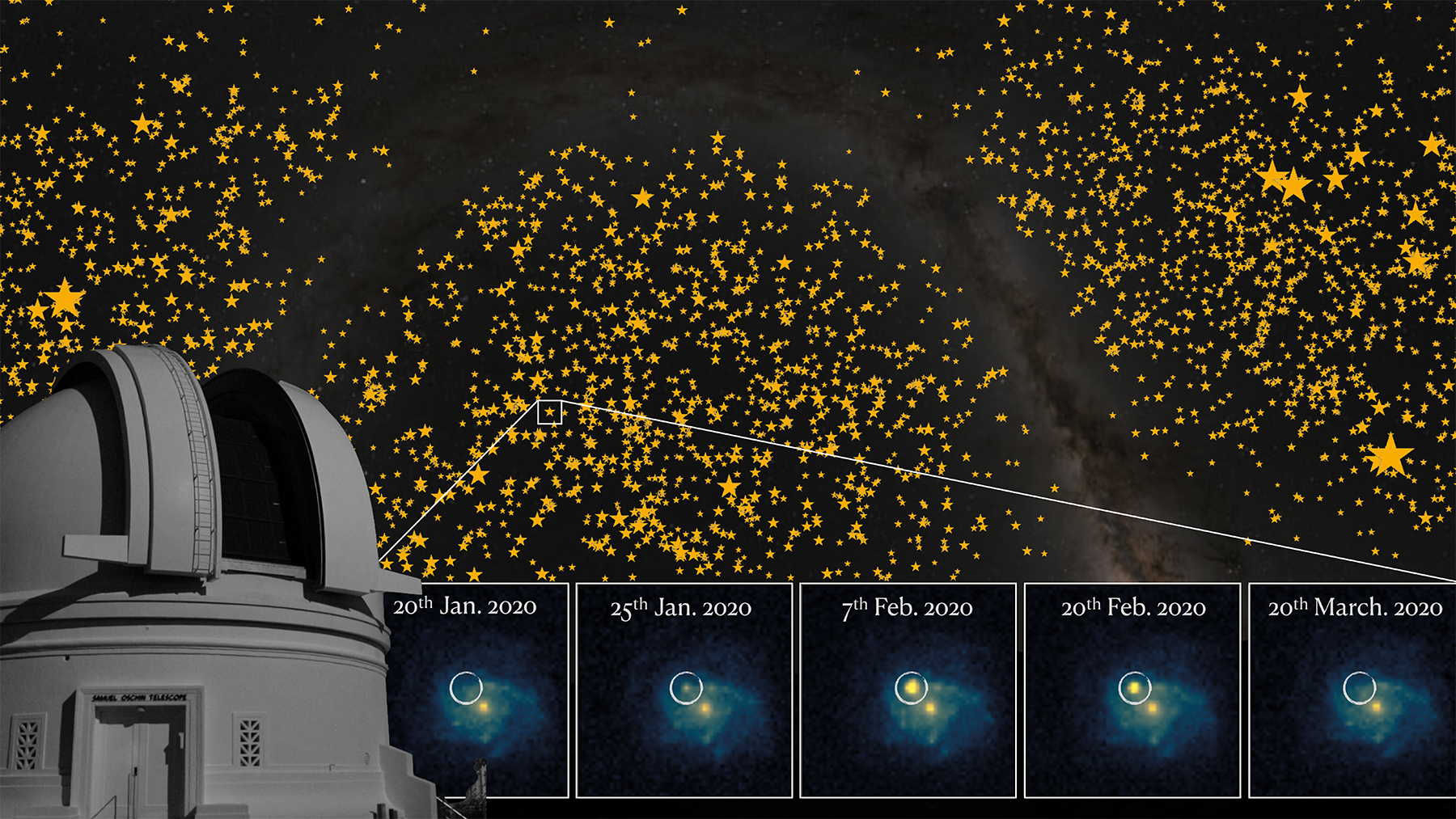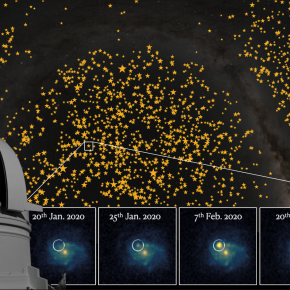The Zwicky Transient Facility survey publishes its long awaited sample of 3628 Type Ia Supernovae
Important facts
- Type Ia Supernovae are cosmic explosions used to measure distances across the universe.
- In 2.5 years, ZTF has doubled the number available Type Ia Supernovae for cosmology acquired for the last 30 years (nearly 3000).
- The collaboration is now releasing this dataset alongside with an Special Issue in Astronomy and Astrophysics made of 21 publications.
- This release opens the era of high precision in Supernovae Cosmology, and the ZTF team discovered a new effect that could change how cosmologists measure the expansion history of the Universe.
Type Ia supernovae are the dramatic explosions of white dwarf stars at the ends of their lives. Approximately 2 weeks later, each single event reaches a peak luminosity of 10 millions sun-like stars with a remarkable consistency between different events. We call these objects “standard candles”. Cosmologists have learned to use them to probe distances across the universe by comparing their fluxes, as further objects appear dimmer. The acceleration of the Universal expansion, awarded by the Nobel prize in 2011, has been discovered in the late 90s using ~100 of these Supernovae. Since then, cosmologists are investigating the reason for this acceleration caused by the dubbed dark energy that plays the role of an anti-gravity force across the Universe. Recent state-of-the-art Type Ia Supernovae datasets compile ~2000 objects gathered from many different telescopes and acquired for the last two decades. Interestingly, analyses of these samples suggest that dark energy may be more complicated than a simple mathematical constant in Einstein’s equation as assumed since its first discovery ; but then what ? Unfortunately, improvement of our understanding of the dark energy properties has been limited by our sparse knowledge of the exact physics responsible for the Type Ia Supernovae astrophysical phenomenon, which in turn affects our ability to derive precision distances to probe the fundamental physics of the Universe.

Today, the Zwicky Transient Facility survey (ZTF) publishes 3628 highly sampled Type Ia Supernovae data acquired by a single instrument between March 2018 and December 2020, unveiling new insights on the nature of Type Ia Supernovae and their use as cosmological candles. “For the past five years, a group of thirty experts from around the world have collected, compiled, assembled, and analyzed these data. We are now releasing it to the entire community. This sample is so unique in terms of size and homogeneity, that we expect it to significantly impact the field of Supernovae cosmology and to lead to many additional new discoveries in addition to results we have already published”, says Dr. Mickael Rigault, researcher at the Institut des deux Infinis de Lyon (CNRS / Claude Bernard University) and head of the ZTF Cosmology Science working group.
Understanding Dark Energy and Supernova Physics
For decades, Type Ia supernovae have played a pivotal role in the discovery and study of dark energy—the mysterious force responsible for the accelerating expansion of the Universe. To do so, cosmologists compare two quantities: the redshift, i.e., the photon’s wavelength stretch caused by the geometrical expansion of the Universe ; and the Supernovae brightness, which indicates the distance of the light source, and thus the time it took for the photon to reach us. Together, these quantities enable us to probe the expansion history of the Universe and consequently the fundamental physics responsible for it.
Yet, the exact nature of Type Ia supernovae remains somewhat unknown. We know from studying spectra and rate of brightness evolution with time, aka. lightcurves, that this phenomenon arises from the thermonuclear explosion of a Carbon/oxygen white dwarf, very likely from a binary (or more) system. But why this white dwarf exploded, how its composition or that of its companion star influenced the explosion mechanism remains unclear. There could even be multiple channels leading to similar events. Hence the question for cosmology: how accurate are distance measurements derived from Type Ia Supernovae lightcurves despite our limited knowledge on what these objects truly are ?
This question has been the focus of the current ZTF release, “With this large and homogeneous dataset, we can explore Type Ia supernovae with an unprecedented level of precision and accuracy,” comments Dr. Mickael Rigault, “This is a crucial step toward honing the use of Type Ia Supernovae in cosmology and assess if current deviations in cosmology are due to new fundamental physics or unknown problem in the way we derive distances.”
Distances of complex Candles
To tackle this core scientific question, the ZTF group has focused with this release on three aspects.
First, they studied the diversity of the Type Ia Supernovae events, unveiling sub-populations and extreme objects to probe the homogeneity of the core sample ; this led to refining which Supernovae should indeed be used for cosmology as they are the most alike.
Second, we probe how Type Ia Supernovae vary as a function of their environments, be it made of young or old stars, having lots of interstellar dust or stripped from any gas. This informs us about the origin of observed variabilities: are they connected to the progenitor system material, the speed of evolution from the progenitor star formation to the resulting white dwarf explosion as a Supernovae. Or are these observed variations more directly connected to line-of-sight influence of host galaxy materials such as interstellar dust. With this second aspect we attend to best correct observed variabilities to access accurate distances within requiring to know the Supernovae nature.
This is the focus of the third scientific aspect: studying the early and late lightcurves points and spectra we uniquely have acquired with ZTF to directly probe the physics of the progenitor system. “Thanks to ZTF’s unique ability to scan the sky rapidly and deeply, we have captured multiple supernovae within days—or even hours—of explosion, providing novel constraints on how they end their lives.” highlights Prof. Kate Maguire from Trinity College Dublin, a co-author of the study.
Co-author Prof. Ariel Goobar, the director of the Oskar Klein Centre in Stockholm, one of the founding institutions of ZTF, and also member of the team that discovered the accelerated expansion of the Universe in 1998 adds “ultimately, the aim is to address one of our time’s biggest question in fundamental physics and cosmology, namely what is most of the Universe made of? For that we need the ZTF supernova data.”
All together, the ZTF cosmology science working group is publishing 21 articles studying these 3628 Type Ia Supernovae, forming a Special Issue in Astronomy & Astrophysics. One of the key outcomes of these studies is that Type Ia Supernovae intrinsically vary as a function of their host environment, more so than expected before, and the correction mechanism assumed so far has to be revisited. This could change how we measure the expansion history of the Universe and may have important consequences for current deviation observed in the standard model of cosmology. These are now being investigated.
A Unique Instrument, for a groundbreaking dataset.
The ZTF camera, installed on the 48-inch Schmidt telescope at Palomar Observatory, scans the entire northern sky daily in three optical bands thanks to its 47 square degree camera and rapid 30s acquisition. In that short time, the ZTF camera reaches a depth of 20.5 magnitude, so one million times fainter than the dimmest stars visible to the naked eye. This sensitivity allows ZTF to detect nearly all supernovae within 1.5 billion light-years of Earth. This is the first time that astrophysicists have access to such a large and homogeneous dataset. Because Type Ia supernovae are rare, occurring approximately once per thousand years in a typical galaxy, but ZTF’s depth and survey strategy enable researchers to detect nearly four per night.
Hence, previous supernova samples covering this distance range contained fewer than 200 events. The ZTF SN Ia DR2 dataset increases this number by an order of magnitude, enabling much more accurate analyses, study of rare events, comparing similarities and differences between many sub-groups etc… This breakthrough allows researchers to address fundamental questions previously hindered by limited sample sizes. “This release provides a game-changing dataset for supernova cosmology,” says Dr. Mathew Smith, co-leader of the ZTF SN Ia DR2 release and now Lecturer in Astrophysics at Lancaster University. “It opens the door to new discoveries about both the expansion of the universe and the fundamental physics of supernovae.”
“We are providing the community with thousands of density sampled and well calibrated Type Ia Supernovae light curves, spectra, host properties, and observing logs. These resources will enable researchers to refine models and develop new techniques to enhance the precision and accuracy of distances derived from SN Ia observations,” summarizes Dr. J. Nordin, head of the Berlin ZTF Cosmology Group.
"The uniformity of this dataset sets a new standard for nearby supernova observations, surpassing all those collected over the past decades. It will serve as the reference for future high-redshift supernova studies, including those from next-generation projects like the Legacy Survey of Space and Time (LSST) and the Roman Space Telescope, bringing us closer to understanding the true nature of dark energy that drives the accelerating expansion of the Universe" concludes Dr. Lluís Galbany, researcher at the Institute of Space Sciences (ICE-CSIC) in Barcelona.
For more information and access to the dataset, visit: ZTF SN Ia DR2 website
The institutions involved in the study are : Caltech (California, United States of America), CNRS (France), Humboldt Universiteat (Berlin, Germany), Institut d'Estudis Espacials de Catalunya (Barcelona, Spain), Lancaster University (Lancaster UK), Oskar Klein Center (Stockohlm, Sweden), Trinity college (Dublin, Ireland).
